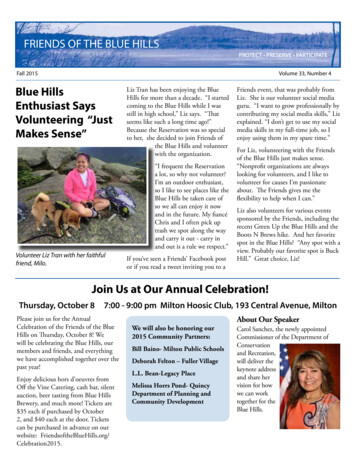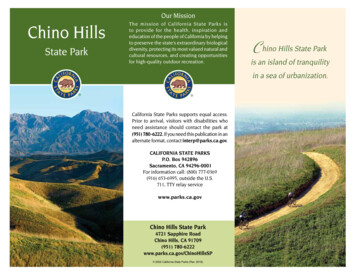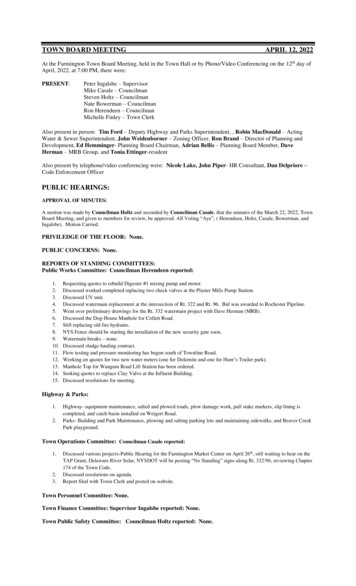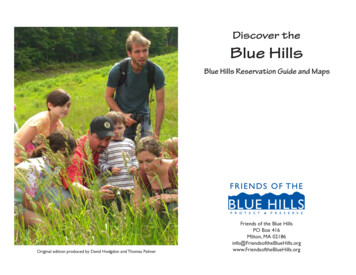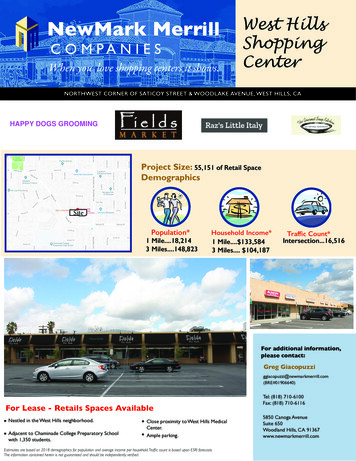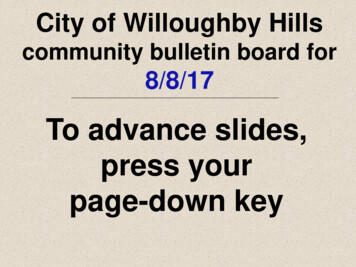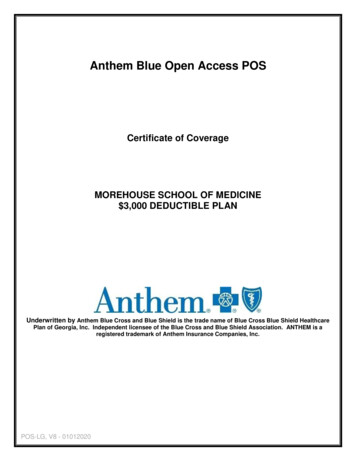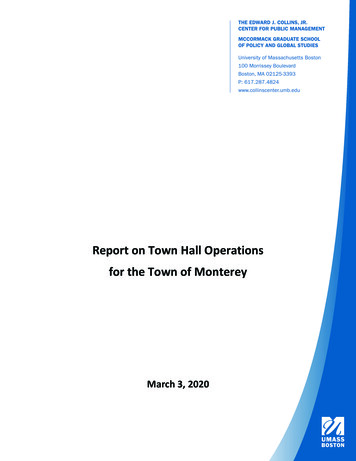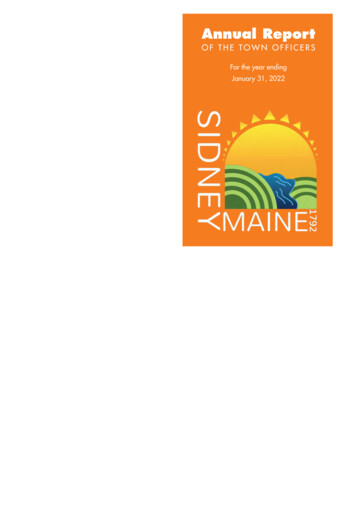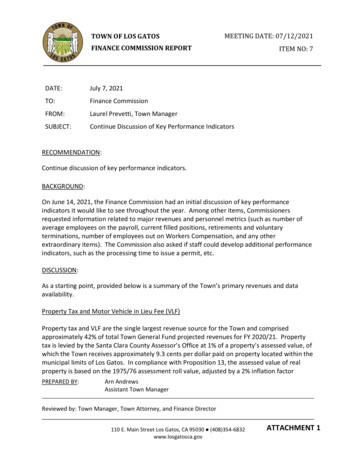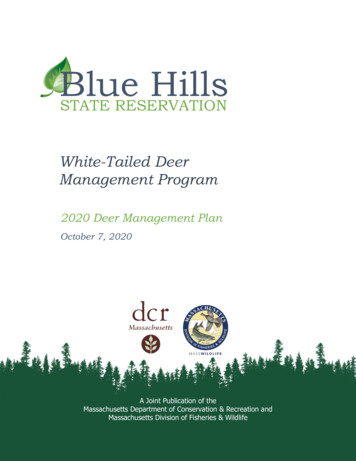
Transcription
BlueHillsSTATE RESERVATIONWhite-Tailed DeerManagement Program2020 Deer Management PlanOctober 7, 2020A Joint Publication of theMassachusetts Department of Conservation & Recreation andMassachusetts Division of Fisheries & Wildlife1
Commonwealth of MassachusettsCharles D. BakerGovernorKaryn E. PolitoLt. GovernorExecutive Office of Energy & Environmental AffairsKathleen A. TheoharidesSecretaryDepartment of Conservation & RecreationJim MontgomeryCommissionerDepartment of Fish & GameRonald AmidonCommissionerMassachusetts Division of Fisheries & WildlifeMark TisaDirector2
Table of Contents1.0The DCR Blue Hills Reservation42.0Context for Deer Management in the Blue Hills43.0Rationale & Objectives for Deer Management in the Blue Hills54.0Context & Need for Continued Deer Management55.0Permitted Archery Hunting During November76.0COVID-19 Considerations93
1.0The Blue Hills ReservationThe Massachusetts Department of Conservation and Recreation(DCR) manages and stewards the Blue Hills Reservation. TheReservation encompasses an area of over 7,000 acres and issituated less than ten miles south of downtown Boston in thecommunities of Braintree, Canton, Dedham, Milton, Quincy, andRandolph. A small portion of Fowl Meadow (north and west of theNeponset River) is located within the Hyde Park neighborhood ofthe City of Boston. The protection of this area as public openspace began over 120 years ago with its establishment in 1893by the Metropolitan Park Commission. As a public parkland andforested area, the Reservation contains a wide variety of naturalresources, vegetation, wildlife, and cultural and archaeologicalresources, and its topography includes prominent hills (Great BlueHill and Chickatawbut Hill), as well as open fields and severalponds and streams.2.0Context for Deer Management in the Blue HillsThe Massachusetts Department of Conservation and Recreation (DCR) and the Massachusetts Division of Fisheriesand Wildlife (MassWildlife) have legislative mandates and missions to protect and manage a myriad of naturalresources including forests, wildlife, and the habitats upon which a diversity of wildlife depends. From the canopyto the understory, healthy forest ecosystems are made up of trees and plants of multiple species and age classesand the diversity of vegetation provides suitable and sustainable habitat for a rich and varied wildlife community.From the perspective of long-term forest management, tree regeneration is critical to the long-term survival offorests and their ability to recover from natural disturbances. Forests that contain high deer population densitiesare vulnerable to deer over-browsing young trees, which can prevent forest regeneration. In addition, extremelyhigh deer densities can promote the spread of some invasive species and significantly reduce biodiversity.DCR’s management of the Blue Hills Reservation is guided by the existence of a comprehensive ResourceManagement Plan (RMP) that was approved by the DCR Stewardship Council in April 2011 following a robustplanning and development process involving input from local residents, stakeholders, and the Friends of the BlueHills.1 The Blue Hills RMP noted a growing concern over the size of the deer population within the Reservation andthe impact of over-browse on rare plants and other vegetation throughout the Reservation. DCR has becomeincreasingly concerned with the long-term health of the Reservation’s forest and the ecological impacts of sustainedhigh deer densities on this natural resource. The RMP explicitly recommended that the agency work withMassWildlife to estimate the size of the deer population, determine its impacts on the Reservation’s naturalresources, and discuss deer management options. 21The Friends of the Blue Hills is a non-profit organization that works both independently and in cooperation with the DCR topreserve the natural resources of and enhance recreational opportunities in the Blue Hills Reservation. For more informationvisit: http://friendsofthebluehills.org/.2To view a copy of the approved 2011 Blue Hills Resource Management Plan and appendices please use the following ents/2016/08/xd/appendices.pdf4
2.1 – Legislative MandateIn addition to following the recommendations within the Blue Hills RMP, DCR and MassWildlife were issued alegislative mandate in the 2014 Environmental Bond Bill (Chapter 286 of the Acts of 2014), which was signed intolaw by former Governor Deval Patrick in August 2014. Specifically, Section 43 of the bond bill directs DCR (inconsultation with MassWildlife) to “identify areas in which deer overpopulation is negatively impacting forestation,water resources, or plant growth on department-owned land” and “to develop and implement a harvestmanagement plan for the identified areas.”2.2 – Initiation of Deer Management in the Blue HillsIn light of each agency’s mission, the recommendations outlined in the Blue Hills RMP, the results of the deerabundance survey, and the legislative mandate detailed in the 2014 Environmental Bond Bill, DCR and MassWildlifebegan developing a deer management plan for the Blue Hills Reservation in late 2014. Recognizing that deermanagement activities can take several forms, both agencies worked together to analyze, assess, and consider therelative impacts and efficacy of several alternative management approaches for a location like the Blue Hills. Thisplanning process and several public information sessions held in the fall of 2015 resulted in the release of a final2015 Blue Hills Deer Management Plan that recommended the phased implementation of annual controlled deerhunting similar to the very successful annual hunt managed by DCR’s Division of Water Supply Protection at theQuabbin Reservation.3.0Rationale & Objectives for Deer Management in the Blue HillsThe primary objective and rationale for developing and implementing a deer management program is to maintainan ecologically sustainable deer density that allows for the continuous growth and development of forestregeneration. In particular, DCR is trying to reduce the negative impacts that high deer densities have on theregenerating forest to ensure a healthy forest composed of an adequate diversity of tree species and age classes.DCR’s program for white-tailed deer management is not intended to provide a new recreational opportunity in theBlue Hills. Rather, the program provides a concrete, practical, and workable solution intended to deal with a criticalenvironmental problem.The decision to manage the overpopulation of deer in the Blue Hills Reservation is not related to the role of deerin the transmission of Lyme disease or other tick-borne illnesses. DCR recognizes the myriad of researchdemonstrating conflicting results with regard to the correlation between deer densities, tick abundance, and Lymedisease contraction rates among humans. Furthermore, attempting to solve Lyme disease (and other tick-borneillnesses) or reduce contraction rates among humans is not a goal of DCR’s deer management plan for the BlueHills. Rather, as stewards of the Blue Hills Reservation, it is DCR’s objective to reduce (and in the long-term reverse)the negative impacts of high deer densities on the Reservation’s vegetation, promote the restoration of healthyhabitat for other wildlife, and bring deer densities to a level more aligned with what the forest can sustain.4.0Context & Need for Continued Deer Management4.1 – Continued Deer AbundanceDue to COVID-19, the pellet survey that has been used in previous years to estimate deer densities in the Blue HillsReservation was not completed in 2020. The table on the following page lists the various survey sites and providesdensity estimates for the most recent pellet survey conducted in 2019. For comparative purposes, density estimatesfrom the 2018 and 2017 pellet surveys are also provided. For additional information regarding previous year pellet5
surveys, readers are encouraged to read Section 7 of the 2016 Program Overview & Results / 2017 Results of DeerAbundance Surveying report and Section 4 of the 2018 Blue Hills Deer Management Plan.Study SiteFowl Meadow/Little BlueGreat Blue/Houghton’s PondWampatuck/ChickatawbutPonkapoag/Brookwood Farm/Nike SiteBlue Hills – Overall2019 Density Estimate2018 Density Estimate2017 Density Estimate(# of deer/mi2)(# of deer/mi2)(# of deer/mi2)Not Surveyed22.5 / mi229.6 / mi211.2 / mi2Not Calculated136.4 / mi225.4 / mi229.5 / mi220.4 / mi251.6 / mi2mi247.1 /20.4 / mi217.8 / mi221.7 / mi226.4 / mi2The 2019 pellet survey provided an overall density estimate of 26.4 deer/mi2 for the Blue Hills. In general, theresults of this pellet survey show deer numbers that are lower than they were in 2017 and 2018. However,throughout most of the Reservation, deer densities continued to exceed MassWildlife’s statewide goal of 6-18deer/mi2, which is important for reducing impacts to the habitat and forest within and around the Blue HillsReservation.4.2 – Long-Term Effort & CommitmentIn the 2015 Blue Hills Deer Management Plan, DCR and MassWildlife noted that most deer management programsdesigned to address extremely high deer densities typically start with an aggressive reduction phase during theinitial years. Once densities are reduced to a suitable level, a long-term management phase can be implementedutilizing more moderate hunting effort in order to maintain the accomplishments achieved during the reductionphase. This model was successfully implemented as part of the Quabbin Reservoir Watershed deer managementprogram, which began in 1991 with nine (9) days of shotgun hunting. Within a few years, deer densities at theQuabbin were substantially reduced and the program moved from a reduction phase toward a maintenance phase.Today, the Quabbin hunt takes place using a rotation system over the course of only four (4) days in an effort tomaintain current deer densities.In the Blue Hills, however, hunting had not been allowed for over 100 years. As such, DCR decided in 2015 toimplement a controlled hunt on a more limited scale with the goal of working toward expanding the controlled huntprogram in order to achieve more aggressive reductions in future years. This phased approach was explicitlyoutlined in the 2015 Blue Hills Deer Management Plan and in accordance with this plan, DCR has gradually expandedthe size of the huntable areas over the course of four years from 2,980 acres in 2015 to 4,216 acres in 2019 (thisincludes areas opened to archery and shotgun hunting). In addition, while the 2015 hunt only allowed for use ofshotguns, the limited use of archery was introduced in certain designated areas during the 2016 hunt and has beencontinued since then.3DCR and MassWildlife also made it clear within the 2015 Blue Hills Deer Management Plan that successful deermanagement would require a long-term effort and commitment since any reductions achieved can be quickly erasedthrough deer reproduction and migration in the absence of any management. The Quabbin Reservoir provides aprime example of how long-term commitment to deer management is essential. The program has been in operationfor over 25 years and has worked effectively to maintain densities below 20 deer/mi2.3Since initiating this deer management program, DCR and Mass Wildlife have released annual program reports highlightingresults of each controlled hunt. To view a copy of each year’s report, please use the following links: 2015 Program Overview &Results, 2016 Program Overview & Results, 2017 Program Overview & Results , 2018 Program Overview & Results, and 2019Program Overview & Results.6
4.3 – Commitment to Continued Deer Management in 2020The use of licensed public hunters in managing deer populations is one of the most widely used managementmethods employed throughout the United States. In Massachusetts, it is the primary management tool supportedby MassWildlife and has been shown to be successful in addressing situations involving deer overabundance andvegetation over-browse. The Quabbin Reservoir controlled deer hunt is the most notable example. In addition, DCRmanages thousands of acres of forest and parkland across the Commonwealth where licensed hunters are allowedto hunt during the regulated seasons. Moreover, regulated hunting is an activity that DCR fully supports by providingpublic land for hunters to engage in this management activity.In light of DCR’s commitment to long-term deer management in the Blue Hills and in order to continue the successfulefforts undertaken between 2015 and 2019, DCR will continue to implement controlled hunting in the Blue Hills in2020. Based upon the experience of implementing and assessing the outcomes of five controlled hunts and thesuccess of controlled hunting efforts in 2019, DCR and will implement a controlled hunting plan in 2020 that mirrorsthe permitted archery hunt conducted in 2019. All areas included in this year’s hunts have already been opened toarchery hunting in previous years.5.0Permitted Archery Hunting During NovemberOver the last several years (and even prior to DCR’s initiation of controlled deer hunting in the Blue Hills Reservation)a number of private property owners near or adjacent to the Blue Hills have voluntarily allowed archery huntersonto their land during the annual archery season to hunt deer. This informal program has been successful inharvesting a number of deer each year and highlights the importance of cooperation between landowners and deerhunters.5.1 – Timing and LengthTo supplement the efforts already taking place on nearby and adjacent private property and to enhance DCR’soverall Deer Management Program for the Blue Hills Reservation, DCR will continue to permit limited archeryhunting in certain designated areas of the Blue Hills on Mondays through Thursdays between November 16th andDecember 3rd. There will no hunting on Thursday, November 26, 2020 in observation of the Thanksgiving holiday.In accordance with state hunting regulations, hunters will be allowed to start hunting one-half hour before sunriseto one-half hour after sunset.5.2 – Management Areas and Hunter DistributionArchery hunting will be limited to the areas of the Reservation listed in the table and outlined on the map on thenext page.In order to organize and distribute hunters effectively, archery hunters will be separated into two groups and eachgroup will be assigned to one of two archery zones. Each zone will include several management areas. Huntersassigned to Zone 1 may hunt in any of the management areas listed within that zone. Hunters assigned to Zone 2may hunt in any of the management areas listed within that zone. Hunting zones and the management areas withineach zone are outlined in the table on the following page:7
Archery ZoneZONE 1ZONE 2ManagementAreaFowl MeadowLittle BlueBrookwood FarmGreat BlueHoughton’s PondPonkapoagNike SiteChickatawbutWampatuckBraintree SiteTOTALAcres Open to HuntingAcres Open to Hunting(Per Management Area)(Per Zone)Number 004612772,6225.3 – Hunter Selection and Access PermittingLicensed archery hunters must complete and submit an application to DCR to participate in this archery huntingopportunity. All applicants are required to have a valid 2020 Massachusetts hunting license.From among the applicant pool, DCR will conduct a random lottery to select 225 archery hunters to receive accesspermits. These access permits will be valid on all days in which archery hunting will be allowed in designated areasof the Reservation (as outlined above) during the hunting period and permitted hunters will be allowed to huntbased upon their schedule and availability. Given this flexibility, it is highly unlikely that there will be 225 archeryhunters in designated management areas on any given day.If selected to participate, any archery hunter under the age of 18 must be accompanied while hunting by an adultover the age of 21 who is also a registered hunter possessing a valid Massachusetts hunting license. Theaccompanying adult must participate in the mandatory virtual orientation session and will not be allowed to hunt.8
5.4 – Antlerless PermitsMassWildlife will make antlerless deer permits specific to the Blue hills Reservation available to applicants selectedto receive an archery access permit. Selected hunters will be able to purchase their antlerless permits online or atany licensed vendor. Hunters selected to participate will be required to purchase at least two (2) antlerless permits.The use of any Zone 10 antlerless permits will be prohibited from use in the Blue Hills.5.5 – Hunter OrientationAll archery permittees will be required to complete a virtual orientation. Among other topics, the virtual orientationwill cover the elements of the Blue Hills deer Management Plan, the goals and objectives of the program, anorientation to the area, and safety considerations. Any selected archery hunter who fails to fulfill this requirementwill not receive an access permit and will not be allowed to hunt in the Blue Hills.5.6 – Public Recreational AccessGeneral public access for recreation will not be restricted in those areas in which hunting will take place. Membersof the general public who choose to enter those areas in which hunting will be taking place are advised to takeproper precautions by wearing blaze orange clothing, vests, and hats.6.0COVID-19 ConsiderationsIn accordance with the Commonwealth’s phased re-opening plan in response to the COVID-19 pandemic, all huntingactivities are still permitted in accordance with the regulations (including licenses) for the appropriate huntingseason. In addition, hunting is listed within the “Lower Risk” category within the re-opening plan. The use of archeryhunting also allows for greater maintenance of social distancing as archery hunters remain stationary and solitaryon tree stands that are generally away from established trails. As such, the use of archery hunting reduces thepotential for interactions between hunters and between hunters and other members of the public.Permitted hunters participating in the 2020 archery hunt will be required to practice social distancing by remainingat least 6 feet away from other people while hunting in the Blue Hills. In addition, per Governor Baker’s orderregarding the use of face coverings, all permitted hunters will be required to wear a face covering if social distancingcannot be maintained.Finally, any elements of the administration of the Blue Hills archery hunt that in previous years required face-toface interaction between permitted hunters and DCR staff (such as hunter orientation, check-in, harvest reporting,etc.) will be modified to reduce or eliminate the need for such interactions.9
3 Table of Contents 1.0 The DCR Blue Hills Reservation 4 2.0 Context for Deer Management in the Blue Hills 4 3.0 Rationale & Objectives for Deer Management in the Blue Hills 5 4.0 Context & Need for Continued Deer Management 5 5.0 Permitted Archery Hunting During November 7 6.0 COVID-19 Considerations 9
